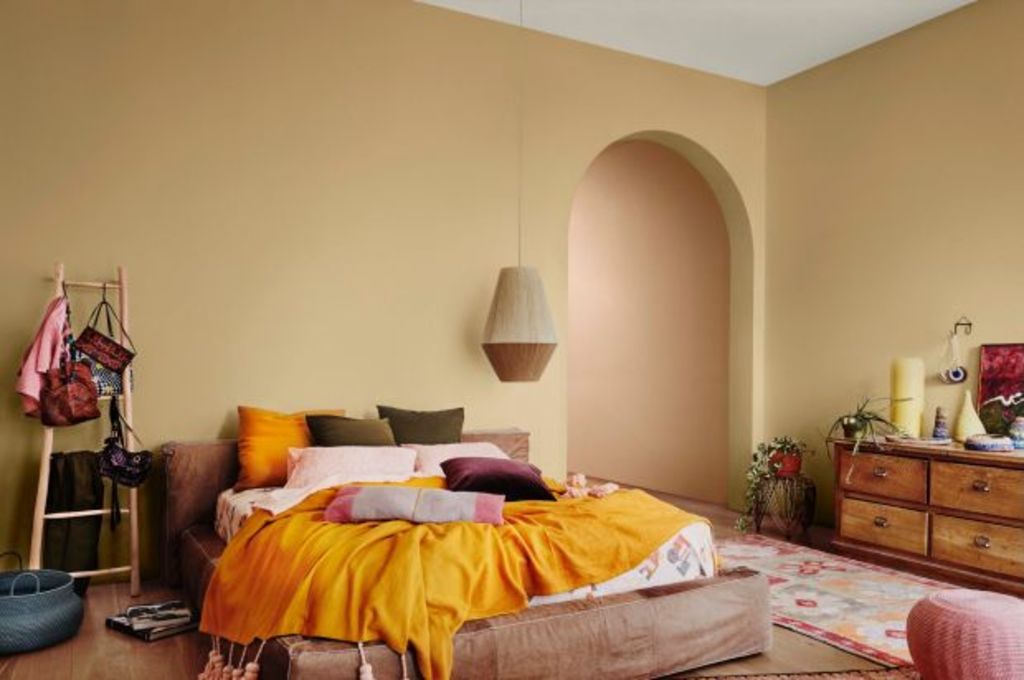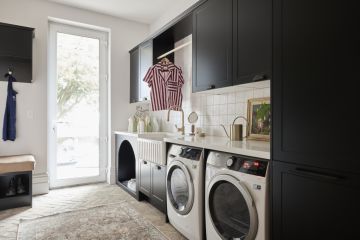Nine expert tips to make your DIY painting project succeed

There is more to a DIY painting project than choosing the right colour. While this is important, so is having the right tools, preparing your surfaces and using the correct painting techniques.
To help ensure your next painting project is a success, we’ve asked the experts for their advice on how to not only paint better, but work faster and neater, too.
Step 1: Determine what areas you’re going to paint
Before you begin anything else, work out exactly what areas you’re going to paint. This will determine how many litres of paint are required (use an online paint calculator to help with this), what type of colour scheme will go with the space and what sheen level is required.
 Using an online paint calculator means you won’t be caught out with too little, or too much, paint. Styling by Michelle Halford for Norsu Interiors. Photo: Lisa Cohen
Using an online paint calculator means you won’t be caught out with too little, or too much, paint. Styling by Michelle Halford for Norsu Interiors. Photo: Lisa Cohen
Step 2: Choose quality materials
Choosing quality tools and materials is critically important as it will have a big impact on your entire painting experience, says Kristy Sadlier, co-founder of Norsu Interiors.
“Investing in quality tools and materials will make the application process easier, and give your project a superior finish.”
There is a misconception that certain areas don’t need quality paint, however this is far from the truth, says Dulux interior product manager Bonnie Jenkinson. “For example, quality ceiling paint can mean easier application, benefits like mould resistance and better coverage means applying less coats, which will actually save you time and money in the long run.”
Step 3: Select the right brushes and rollers
The type and size of the paint brush you should use depends on what exactly you are painting, advises Jenkinson.
“For example, smaller brushes are best used for frames, shutters, furniture, mouldings and touch-ups; medium brushes are great for areas such as skirtings, rails and fence posts; whilst larger brushes are for walls, floors, ceilings, roofs and fence,” she said.
“Additionally, if the area you intend to paint is rather large, it’s best to substitute a paint brush for a roller altogether.”
 Make sure you’ve got the right tools for the right job. Styling: Michelle Halford for Norsu Interiors. Photo: Lisa Cohen
Make sure you’ve got the right tools for the right job. Styling: Michelle Halford for Norsu Interiors. Photo: Lisa Cohen
Step 4: Put together a DIY toolkit
A well stocked toolkit is essential to DIY success. For a painting job, the items you need can be grouped under the “3 Ps”, explains Jenkinson; preparation, protection and paint.
To prepare the area correctly, Jenkinson says you will need things to clean surfaces with something like sugar soap, a bucket and scourer. You’ll also need things to prep the surface, like filler and blade, gap sealant, scraper, sandpaper and sanding block.
For protection, you will need drop sheets and masking tape to catch any drips, and you should wear a dust mask, safety goggles and gloves. When it comes time to do the painting, you will need a can opener, stirring stick, brushes, rollers with an extension handle, a roller tray, paint bucket and turps if using oil-based paints.
Step 5: Set up a staging area
Housing everything in the one place will not only save you time, but also minimise the mess, advises Sadlier.
“You don’t want to be lugging a tin of paint with you from wall to wall, so setting up a staging area table in the centre of the room, or just outside it, where you can store all your equipment, open/pour your paint, and clean brushes/rollers will be a huge help,” she says.
“Not to mention save on spills, and eliminate the time looking for misplaced tools.”
 Be generous with the amount of paint you apply as this will ensure a great finish. Photo: Dulux
Be generous with the amount of paint you apply as this will ensure a great finish. Photo: Dulux
Step 6: Prepare your surfaces
Although preparation can be the most tedious part, it’s also the most crucial phase of any painting project.
“Start by scraping any flaky or loose paint from your surfaces, then focus on any cracks by filling, sanding and priming them,” says Sadlier.
“Follow this by investing time in cleaning your surfaces well, then finish by taping up your zones, covering anything you don’t want painted and you’re ready to go! Your project will be so much easier if you put in the hard yards at the beginning.”
Step 7: Ensure proper painting techniques
Now that you’re ready to paint, it’s best to start with the ceiling, says Jenkinson. This ensures any paint dripped from the ceiling is covered when completing the walls and trims.
Sadlier also suggests to be generous with the amount of paint that you apply as this will help ensure a great finish.
“If you don’t apply enough paint in the first coat, it will leave the surface looking patchy once it has dried,” she says. “Once your first coat is applied, start on your second coat from the same position, and in the same manner, albeit using less pressure.”
 You can always paint over it if doesn’t work out the way you had imagined. Photo: Dulux
You can always paint over it if doesn’t work out the way you had imagined. Photo: Dulux
Step 8: Keep your brush or roller covered between coats
In between coats, wrap your brush and roller in plastic cling film as this should keep them wet for about four hours, Jenkinson says.
“If you need to stop for a quick break, I would suggest also using foil to cover the tray to keep the paint from drying. Use a wire brush to clean any drying paint from around the ferrule while washing your brush.”
Step 9: Don’t overthink it
Last but not least, perhaps the most handy advice of them all when it comes to a DIY paint job is to not overthink it.
“Have fun and don’t be afraid to take a risk with colour,” says Sadlier.
“You can always paint over it if doesn’t work out the way you had imagined. Practice makes perfect after all.”
We recommend
We thought you might like
States
Capital Cities
Capital Cities - Rentals
Popular Areas
Allhomes
More








